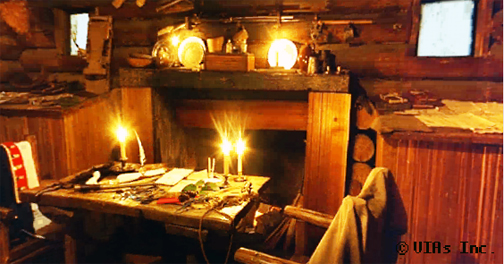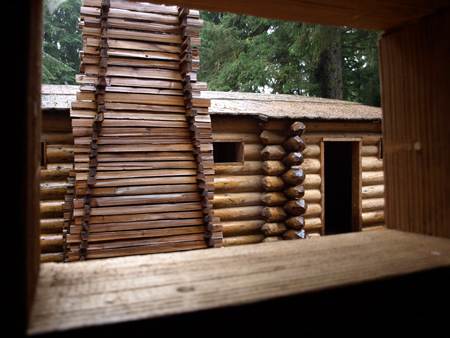Christmas Day
Officers’ Quarters
Fort Clatsop Replica
Allan McMakin photo, 1999. © VIAs Inc./Lewis & Clark Fort Mandan Foundation.
Lewis’s desk is in front of the window at left; Clark’s is at right; the table Joseph Field made for them both is in left foreground. The photo was taken in the replica of the fort that was built in 1955, which accidentally burned to the ground on the night of 3 October 2005. Within months, it was fully rebuilt on the same site.
The Corps of Discovery’s third Christmas celebration together showed that the bonds of brotherhood, woven of travail and triumph, had drawn them close together. There was even a surprisingly large ration of charity in the observance, considering how poor they were on the whole.
Christmas Day at Fort Clatsop was rather warm and, as usual, rainy. At dawn the captains were roused, according to Clark, by “the discharge of the fire arm[s] of all our party & a Selute, Shoute and a Song which the whole party joined in under our windows, after which they retired to their rooms [and] were Chearfull all the morning.”
The “Selute” was, of course, that volley of gunfire. The “shout” was another Southern tradition: If you could surprise someone by shouting “Christmas gift!” first, you were owed one, although, in the spirit of the day, reciprocity certainly was in order.
In another traditional detail, compared with Christmas at Fort Mandan, the observance at Fort Clatsop was just short of grim. “We would have Spent this day the nativity of Christ in feasting,” Clark journaled, “had we any thing either to raise our Sperits or even gratify our appetites. Our Diner concisted of pore [i.e., lean, not fat] Elk, So much Spoiled that we eate it thro’ mear necessity. Some Spoiled pounded fish and a fiew roots.” It was certainly, he emphasized, “a bad Christmass diner.”
Nevertheless, although they were dangerously short of supplies in general, they salvaged the day with gift-giving. The captains had thoughtfully reserved a few treasures for the occasion. They distributed half of their remaining 12 carrots of tobacco among the users, and gave handkerchiefs to the rest of the men. Clark received some woolen clothing from Lewis, moccasins from Private Whitehouse, an Indian basket from Private Goodrich, some tasty roots from the Clatsop Indians, and two dozen weasel tails from Sacagawea, who obviously had started her Christmas shopping early.
Furthermore, Private Joseph Whitehouse noted, the men were “mostly in good health, a blessing which we esteem more than all the luxuries this life can afford.” He continued in a more reverent tone, as if from a familiar prayer book: “. . . the party are all thankful to the Supreme Being, for his goodness towards us . . . . hoping he will preserve us in the same, & enable us to return to the United States again in safety.” Our seasonal greeting today–”Merry Christmas!”–was current at the time of the expedition, as Sergeant Ordway’s remark shows. But the shout with which the men greeted the captains that morning was more than likely the typical Southern greeting of the season, “Christmas gift!” which announced that personal exchanges were in order.
Joseph’s Gift
From the very beginning of the expedition, Joseph Field and his brother Reubin had distinguished themselves as hunters, and that reputation was still unsullied. On 5 February 1806, Reubin would shoot six elk all by himself somewhere up the Netul River (present-day Lewis and Clark River), reloading after each shot, apparently without ever spooking the herd. But today everyone discovered something about Joe that they might not have known before (assuming he had not done the same deed at Fort Mandan, where none of the journalists mentions any aspect of the job). He presented each of the captains with “a wide Slab hued [hewed] to write on.” On the day after Christmas he finished a large table and two benches (foreground in Fig. 6) where Lewis could study and write up his natural history specimens, or Clark could spread out his maps. Clark must have been especially pleased. His portable desk had been demolished when the pack horse bearing it tumbled down a steep mountainside as the company descended into the Lochsa River canyon on 15 September 1805. Lewis had purposely left his in the cache at the portage camp below the Great Falls of the Missouri. No doubt Joe Fields’s presents were a surprise then (and still are), for nothing else we know about him, either from the expedition’s journals or any biographical facts otherwise available, gives us any hint that he had possessed those basic skills all along.
Joe Field might have begun but never successfully completed an apprenticeship as a joiner. Otherwise, perhaps he had enough natural ability and latent interest in the craft that he just felt like playing around with it, using one or more of the small tools in the company’s kit—hand saw and a set of planes—and some odds and ends of the planks they had rived from western redcedar logs. He may also have had a hand in building a tall sturdy cabinet for each board to rest on, since handwriting was a standup job for gentlemen and officers in those days, and space was at a premium even in the captains’ quarters. Lewis’s desk as well as the table and benches, which have been recreated by historic anthropologists for the National Park Service’s modern replica of the fort, is pictured here beneath the window at left; Clark’s desk was under the window to the right of the fireplace.
New Years Day
On 1 January 1806, the captains were “awoke at an early hour by the discharge of a Volley of Small arms, which were fired by our party in front of our quarters to usher in the new year, this was the only mark of respect which we had it in our power to pay this Selibrated day.” But the captains had to get down to business without delay. With information from “the Indians,” Clark made a list of traders who had previously entered the estuary to trade with the natives, 13 in all, including the captain’s names, the “quallity of their Vessels,” and how long it might be before they appeared again. Inexplicably, neither Robert Gray nor his good ship Columbia were mentioned, which might simply mean that Gray’s visit was ancient history to the natives.
Meanwhile, Lewis issued new detachment orders “for the more exact and uniform dicipline and government of the garrison.” Each of the captains supped that evening on a marrow bone and tongue from the two freshly killed elk. Then, as New Year’s Day came to a close, Clark allowed himself a rare moment of homesickness: “[O]ur repast of this day tho’ better than that of Christmas Consisted principally in the anticipation of the 1st day of January 1807, when in the bosum of our friends we hope to participate in the mirth and hilarity of the day, and when with the relish given by the recollection of the present, we Shall Completely, both mentally and Corporally, [relish?] the repast which the hand of Civilization has produced for us.”
Sergeant Gass’s journal for the day centered on a salutary postscript to their three-month postgraduate seminar on survival: “We gave our Fortification the name of Fort Clatsop.”
See also Holidays on the Trail.
Fort Clatsop is a High Potential Historic Site along the Lewis and Clark National Historic Trail managed by the U.S. National Park Service. The site is managed by the Lewis and Clark National and State Historic Parks.—ed.
Experience the Lewis and Clark Trail
The Lewis and Clark Trail Experience—our sister site at lewisandclark.travel—connects the world to people and places on the Lewis and Clark Trail.
Discover More
- The Lewis and Clark Expedition: Day by Day by Gary E. Moulton (University of Nebraska Press, 2018). The story in prose, 14 May 1804–23 September 1806.
- The Lewis and Clark Journals: An American Epic of Discovery (abridged) by Gary E. Moulton (University of Nebraska Press, 2003). Selected journal excerpts, 14 May 1804–23 September 1806.
- The Lewis and Clark Journals. by Gary E. Moulton (University of Nebraska Press, 1983–2001). The complete story in 13 volumes.





